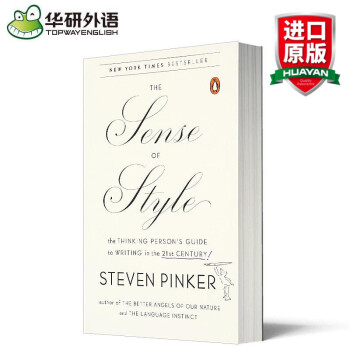

具体描述
书名:The Sense of Style 写作风格的意识
难度:Lexile蓝思阅读指数1260L
作者:Steven Pinker史蒂芬·平克
出版社名称:Penguin Books
出版时间:2015
语种: 英文
ISBN:9780143127796
商品尺寸:13.4 x 2 x 20.2 cm
包装:平装
页数:368
纽时作家、Language Instinct《语言本能》作者
享誉国际的认知科学 ╳ 心理语言学家
为21世纪知识分子所写的英语写作指南
良好的写作并非本能,对人类来说,这甚至是项艰难的任务;然而,这不代表我们无法透过后天努力掌握这项技艺,更不代表学习过程必然枯燥而充满教条;事实上,这可以是一场迷人的心智旅程。
The Sense of Style《写作风格的意识》是为了有英文写作的需求,并期望提升此项能力的人们而撰。此外,如果对文学有兴趣,或希望了解心智科学如何帮助人们理解语言的运作,也能从本书获得启发。
搭配丰富的正反实例,作者告诉我们:
·透过大量阅读提升品味和语感
·让读者与文章主题产生清楚链接
·去除知识构成的理解障碍
·避免不恰当的文章结构误导读者
·确保文章具一致性与逻辑性
·掌握正确语法
掌握以上数点,并经过假以时日的练习,就能写出论述清晰而又兼具风格的英语好文章。
推荐理由:
1. 世界知名语言学家、TED演讲人、《语言本能》作者史蒂芬·平克新著作;
2. 引用大量优美的文章,说明如何能使文章好看且易于阅读;
3. 笔法及引用的例子特殊,市场相对少见;
4. 旁征博引,丰富的语言学、科学与心智科学知识,提供读者丰富多元的阅读厚度。
名家推荐:
“本书优雅而清晰地一击即中,推翻了所谓英语快烂得要丢去喂狗了的说法。平克为新世纪写了像史壮克和怀特(Strunk and White)那样的经典之作,同时劝导人们抛弃没有根据的无稽之谈,譬如指称那个广告老口号该说成:‘Winston tastes good as a cigarette should.’(云丝顿好味道,香烟就该这么好。)” ——约翰·麦克霍特(John McWhorter)(《伟哉!我们的杂种语言》(Our Magnificent Bastard Tongue)和《巴别塔的力量》(The Power of Babel)的作者)
“干得好!只有平克才能写出这本了不起的好书,也谢天谢地他真把它写了出来。他写道:“好文章能把我们对世界的观感翻转过来。”《写作风格的意识》一书也能把你对好文章的想法翻转过来。书中每一页都散发着平克的好奇之心和欣喜之情;而当他说,风格可以令世界变得更美好,我们都信以为真。” ——帕特里克·欧康纳(Patricia T. O’Conner)(《我何其不幸》(Woe Is I)的作者,并与史都华·凯勒曼(Stewart Kellerman)合着《似是而非的起源》(Origins of the Specious)
“能有像他那样活泼而澄明的心智,把认知科学的意念带给普罗大众,真是一桩好事。” ——德格拉斯·霍夫斯达德(Douglas Hofstadter《洛杉矶时报》)
“Charming and erudite,” from the author of the forthcoming Enlightenment Now (February 2018), “The wit and insight and clarity he brings… is what makes this book such a gem.” —Time.com
Why is so much writing so bad, and how can we make it better? Is the English language being corrupted by texting and social media? Do the kids today even care about good writing—and why should we care? From the author of The Better Angels of Our Nature and the forthcoming Enlightenment Now
In this entertaining and eminently practical book, the cognitive scientist, dictionary consultant, and New York Times-bestselling author Steven Pinker rethinks the usage guide for the twenty-first century. Using examples of great and gruesome modern prose while avoiding the scolding tone and Spartan tastes of the classic manuals, he shows how the art of writing can be a form of pleasurable mastery and a fascinating intellectual topic in its own right.The Sense of Style is for writers of all kinds, and for readers who are interested in letters and literature and are curious about the ways in which the sciences of mind can illuminate how language works at its best.
Review
Praise forThe Sense of Style
“[The Sense of Style] is more contemporary and comprehensive than ‘The Elements of Style,’ illustrated with comic strips and cartoons and lots of examples of comically bad writing. [Pinker’s] voice is calm, reasonable, benign, and you can easily see why he’s one of Harvard’s most popular lecturers.”—The New York Times
“Pinker’s linguistical learning… is considerable. His knowledge of grammar is extensive and runs deep. He also takes a scarcely hidden delight in exploding tradition. He describes his own temperament as ‘both logical and rebellious.’ Few things give him more pleasure than popping the buttons off what he takes to be stuffed shirts.”—The Wall Street Journal
“[W]hileThe Sense of Style is very much a practical guide to clear and compelling writing, it’s also far more…. In the end, Pinker’s formula for good writing is pretty basic: write clearly, try to follow the rules most of the time—but only the when they make sense. It’s neither rocket science nor brain surgery. But the wit and insight and clarity he brings to that simple formula is what makes this book such a gem.”—Time.com
“Erudite and witty… With its wealth of helpful information and its accessible approach,The Sense of Style is a worthy addition to even the most overburdened shelf of style manuals.”—Shelf Awareness
纽时作家、《语言本能》作者
享誉国际的认知科学 ╳ 心理语言学家
结合科学家的洞见及语法的新发展
传授你写好文章的艺术
为什么那么多文章如此糟糕,该怎样改善?
英语正因为短讯和社交媒体而变坏吗?
的孩子还会注重良好的写作吗?
那我们任何人为什么还要注重它?
在这本有趣而富启迪意义的书里,认知科学家、语言学家暨书作者史蒂芬·平克重新构思了一部二十一世纪的语文用法指南。他没有慨叹语言的堕落,没有在一些恼人的语言问题上吹毛求疵,也没有把一个世纪前语文指南中的可疑规则照录如仪,取而代之,他把语言和心智科学的洞见应用到富挑战性的任务上:如何打造清晰、具一致性而别具风格的文章。
他说,不要把问题归咎于网路或的小孩;良好写作从来是艰难的任务。他从品味别人的好文章起步。他要让想象力发挥作用:营造一种幻觉,彷佛把读者的目光引导到世间的事物。作者必须克服知识的诅咒——这种障碍令我们难以想象别人对我们所认知的如何毫无概念。熟练的作者必须能敏锐觉察句法如何把纠结不清的意念转化为直线式句子。他们还必须把文章编织成具一致性的整体,流畅地一句一句接续下去。还有,他们要懂得拿捏正确的语文用法,把有助文章变得清晰和优雅的规则跟迷思和迷信区别开来。
书中从现代文章中撷取了大量正面和反面例子,避免了古典风格手册的责备语气和武断口吻,揭示写作艺术是掌握一种本领的愉悦经验,也是令人着迷的智性活动。《写作风格的意识》适合各种各样的作者,它的读者对象,则包括对文艺或文学有兴趣,而希望了解心智科学如何能发挥妙用让我们瞥见语言怎样运作。
What is the secret of good prose? Does writing well even matter in an age of instant communication? Should we care? In this funny, thoughtful book about the modern art of writing, Steven Pinker shows us why we all need a sense of style.
More than ever before, the currency of our social and cultural lives is the written word, from Twitter and texting to blogs, e-readers and old-fashioned books. But most style guides fail to prepare people for the challenges of writing in the 21st century, portraying it as a minefield of grievous errors rather than a form of pleasurable mastery. They fail to deal with an inescapable fact about language: it changes over time, adapted by millions of writers and speakers to their needs. Confusing changes in the world with moral decline, every generation believes the kids today are degrading society and taking language with it. A guide for the new millennium, writes Steven Pinker, has to be different.
Drawing on the latest research in linguistics and cognitive science, Steven Pinker replaces the recycled dogma of previous style guides with reason and evidence. This thinking person’s guide to good writing shows why style still matters: in communicating effectively, in enhancing the spread of ideas, in earning a reader’s trust and, not least, in adding beauty to the world. Eye-opening, mind-expanding and cheerful,The Sense of Style shows that good style is part of what it means to be human.
Prologue
Chapter 1 Good Writing
Chapter 2 A Window onto the World
Chapter 3 The Curse of Knowledge
Chapter 4 The Web, the Tree, and the String
Chapter 5 Arcs ofCoherence
Chapter 6 Telling Right From Wrong
Acknowledgments
Glossary
Notes
References
Index
史蒂芬·平克 Steven Pinker是屡屡获奖的认知科学家和公共知识分子。他是《美国传统英语词典》(American Heritage Dictionary of the English Language)用法小组主席,也是《语言本能》(The Language Instinct)、《词与规则》(Words and Rules)和《思维素材》(The Stuff of Thought)等书备受赞誉的作者。他是哈佛大学心理学系约翰斯东家族(Johnstone Family)讲座教授,现居波士顿和麻州特鲁罗市(Truro)。
平克曾获奖项包括:
皇家科学院亨利·戴尔奖(Henry Dale Prize, Royal Institution, 2004)
华特·凯斯勒书籍奖(Walter P. Kistler Book Award, 2005)
美国人道主义协会年度人道主义奖(Humanist of the Year award, issued by the AHA, 2006)
认知神经科学学会乔治·米勒奖(George Miller Prize, Cognitive Neuroscience Society, 2010)
理查·道金斯奖(Richard Dawkins Award, 2013)
Steven Pinker is the Johnstone Professor of Psychology at Harvard University. He has been listed among Foreign Policy magazine’s “Top 100 Public Intellectuals” and Time’s “The 100 Most Influential People in the World.” He is currently chair of the Usage Panel ofThe American Heritage Dictionary.
Prologue
I love style manuals. Ever since I was assigned Strunk and White’s The Elements of Style in an introductory psychology course, the writing guide has been among my favorite literary genres. It’s not just that I welcome advice on the lifelong challenge of perfecting the craft of writing. It’s also that credible guidance on writing must itself be well written, and the best of the manuals are paragons of their own advice. William Strunk’s course notes on writing, which his student E. B. White turned into their famous little book, was studded with gems of self-exemplification such as “Write with nouns and verbs,” “Put the emphatic words of a sentence at the end,” and best of all, his prime directive, “Omit needless words.” Many eminent stylists have applied their gifts to explaining the art, including Kingsley Amis, Jacques Barzun, Ambrose Bierce, Bill Bryson, Robert Graves, Tracy Kidder, Stephen King, Elmore Leonard, F. L. Lucas, George Orwell, William Safire, and of course White himself, the beloved author of Charlotte’s Web and Stuart Little. Here is the great essayist reminiscing about his teacher:
I like to read style manuals for another reason, the one that sends botanists to the garden and chemists to the kitchen: it’s a practical application of our science. I am a psycholinguist and a cognitive scientist, and what is style, after all, but the effective use of words to engage the human mind? It’s all the more captivating to someone who seeks to explain these fields to a wide readership. I think about how language works so that I can best explain how language works.
But my professional acquaintance with language has led me to read the traditional manuals with a growing sense of unease. Strunk and White, for all their intuitive feel for style, had a tenuous grasp of grammar.2 They misdefined terms such as phrase, participle, and relative clause, and in steering their readers away from passive verbs and toward active transitive ones they botched their examples of both. There were a great number of dead leaves lying on the ground, for instance, is not in the passive voice, nor does The cock’s crow came with dawn contain a transitive verb. Lacking the tools to analyze language, they often struggled when turning their intuitions into advice, vainly appealing to the writer’s “ear.” And they did not seem to realize that some of the advice contradicted itself: “Many a tame sentence . . . can be made lively and emphatic by substituting a transitive in the active voice” uses the passive voice to warn against the passive voice. George Orwell, in his vaunted “Politics and the English Language,” fell into the same trap when, without irony, he derided prose in which “the passive voice is wherever possible used in preference to the active.”
Self-contradiction aside, we now know that telling writers to avoid the passive is bad advice. Linguistic research has shown that the passive construction has a number of indispensable functions because of the way it engages a reader’s attention and memory. A skilled writer should know what those functions are and push back against copy editors who, under the influence of grammatically na?ve style guides, blue-pencil every passive construction they spot into an active one.
Style manuals that are innocent of linguistics also are crippled in dealing with the aspect of writing that evokes the most emotion: correct and incorrect usage. Many style manuals treat traditional rules of usage the way fundamentalists treat the Ten Commandments: as unerring laws chiseled in sapphire for mortals to obey or risk eternal damnation. But skeptics and freethinkers who probe the history of these rules have found that they belong to an oral tradition of folklore and myth. For many reasons, manuals that are credulous about the inerrancy of the traditional rules don’t serve writers well. Although some of the rules can make prose better, many of them make it worse, and writers are better off flouting them. The rules often mash together issues of grammatical correctness, logical coherence, formal style, and standard dialect, but a skilled writer needs to keep them straight. And the orthodox stylebooks are ill equipped to deal with an inescapable fact about language: it changes over time. Language is not a protocol legislated by an authority but rather a wiki that pools the contributions of millions of writers and speakers, who ceaselessly bend the language to their needs and who inexorably age, die, and get replaced by their children, who adapt the language in their turn.
用户评价
读罢全书,我有一种豁然开朗的感觉,仿佛有人为我打开了一扇通往更高维度写作境界的侧门。以往我总是在纠结于遣词造句的细枝末节,而忽略了文章的整体“气场”。这本书却将目光放得更远,它探讨了如何构建一个能引导读者心神、让他们自然而然地接受你观点的叙事节奏和布局。它对“模糊性”的讨论尤为精妙,指出在某些情境下,精确的缺失反而能带来更强的感染力,这与许多强调绝对清晰的写作指南形成了鲜明的对比。这种对语境的敏感度,是经验积累才能获得的,而作者却能将其提炼成清晰的原则。此外,书中穿插的那些充满智慧的轶事和历史典故,为原本可能枯燥的理论注入了人文的温度,让阅读过程本身也成为一种享受,它真正做到了寓教于乐,让读者在不知不觉中,提升了自己的“文字品味”。
评分这本书真正击中了现代写作的痛点:在信息爆炸的时代,如何确保你的声音能被清晰地听见,而不是被淹没在噪音之中。我过去常犯的毛病是,为了显得“有学问”,总爱用些冗长复杂的长句,结果自己写完都不忍卒读。这本书则像一剂清醒剂,它用大量的实例对比,清晰地揭示了“复杂”与“清晰”之间的巨大鸿沟。它并没有鼓吹彻底的简化,而是提倡一种恰到好处的“精确性”。作者似乎对读者的耐心极限有着深刻的洞察,他教会我的不是如何堆砌辞藻,而是如何像一位精密的钟表匠一样,打磨每一个词语和标点符号,确保它们都在最佳的位置上发挥作用。特别是关于“动词的运用”那一章节,简直是醍醐灌顶,让我意识到自己过去对那些强劲有力的动词的使用是多么的吝啬和不负责任。这本书带来的改变是实打实的,它让我的邮件沟通效率提升了,学术报告也变得更有穿透力了。
评分这部作品的问世,着实让人眼前一亮,它不像那些堆砌着晦涩难懂的语法规则的传统教材那样令人望而生畏。相反,它像一位经验丰富的向导,带着你穿越纷繁复杂的语言迷雾,直抵清晰、有力的表达核心。我尤其欣赏作者那种娓娓道来的叙事方式,仿佛跟你坐在壁炉边,聊着写作的那些“玄而又玄”的窍门。书里探讨的那些关于句子结构的美学,远超出了教科书上的死板定义,它更关注的是读者在阅读时的“体验感”——那种信息流动的顺畅与否,简直是把写作变成了一种感官艺术来教授。很多时候,我们写出来的东西,自己都觉得拗口,却说不出所以然,这本书却能精准地剖析出“别扭”的根源,然后提供一种更优雅、更具说服力的替代方案。它没有强迫你去遵循某些教条,而是启发你去思考“为什么”某种表达会更有效,这种由内而外的觉醒,才是真正的高级教学。读完后,我发现自己看待自己和他人的文章的视角都发生了一种微妙的、但极其关键的转变,从关注“对错”转向了追求“效果”。
评分对于那些渴望从“写得还行”迈向“写得出色”的严肃作者而言,这本书无疑是一份宝贵的地图。它并没有承诺任何快速致富的捷径,而是诚实地展示了优秀写作背后所需要的思考深度和结构洞察力。我特别喜欢它对于“风格即是个性在精确表达中的显现”这一观点的坚持。它鼓励读者去发现并强化自己独有的声音,而不是去模仿任何单一的范本。书中关于如何处理复杂信息的层次结构,如何设计引人入胜的开篇和令人回味的结尾,都有非常独到且实用的见解。它教会我的最重要一课是:写作的最终目的不是取悦语法老师,而是与你的读者建立一种真诚、高效、并且令人愉悦的连接。这种注重“读者体验”的指导方针,使得这本书超越了一般的技术手册,更像是一部关于如何进行有效沟通的心法秘籍。
评分坦白说,刚开始翻阅时,我还有些疑虑,毕竟市面上同类书籍汗牛充栋,大多雷同。但这本书的独特之处在于,它似乎对语言的“人性”有着深刻的理解。它没有将写作视为一种纯粹的逻辑建构,而是承认了人类大脑在信息处理上的天然偏好和局限性。这种基于认知科学的写作指导,使得书中的建议不再是空洞的说教,而是具有坚实的理论基础和实践意义。举个例子,它对“并行结构”的论述,不仅仅是告诉你“要对称”,而是解释了为什么大脑对对称和节奏有天生的亲近感,这种“知其所以然”的过程,极大地增强了学习的内驱力。我个人非常欣赏作者在引用前人经典与提出新见解之间找到的平衡点,既尊重了语言传统的精髓,又鼓励我们勇于打破那些早已过时的、僵化的“规则”。这让写作练习不再是机械的模仿,而是一场富有创造性的探索。
相关图书
本站所有内容均为互联网搜索引擎提供的公开搜索信息,本站不存储任何数据与内容,任何内容与数据均与本站无关,如有需要请联系相关搜索引擎包括但不限于百度,google,bing,sogou 等
© 2025 book.coffeedeals.club All Rights Reserved. 静流书站 版权所有





![[现货]印象派 绘画艺术作品集 英文原版 Impressionism 印象主义 Tasch pdf epub mobi 电子书 下载](https://pic.windowsfront.com/24769193756/5a5f46d6N6aaad10d.jpg)





![[现货]汪汪队英文绘本书12册盒装 英文原版进口图书 Paw Patrol Phonics 全彩套装 pdf epub mobi 电子书 下载](https://pic.windowsfront.com/26997879848/5aebde62N0b7d52ce.jpg)




![Tuesday 疯狂星期二 [精装] [4岁及以上] pdf epub mobi 电子书 下载](https://pic.windowsfront.com/19000005/55e0eb2e-2adc-4244-a233-e223baba92d7.jpg)
![The Annotated Milton: Complete English Poems [平装] pdf epub mobi 电子书 下载](https://pic.windowsfront.com/19017157/rBEhWFHmb6MIAAAAAAWi6ryViZkAABISAEca3wABaMC618.jpg)
![Because of Winn-Dixie(Audio CD) 英文原版 [平装] [08--12] pdf epub mobi 电子书 下载](https://pic.windowsfront.com/19037360/57b55da6Nc1945992.jpg)
![Start Something That Matters 英文原版 [精装] pdf epub mobi 电子书 下载](https://pic.windowsfront.com/19041495/8962cb9c-046a-4648-9e52-118637a917ce.jpg)
![Execution: The Discipline of Getting Things Done [精装] pdf epub mobi 电子书 下载](https://pic.windowsfront.com/19041582/56e91950N589c5f2c.jpg)